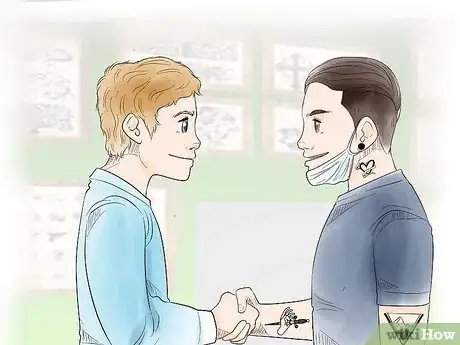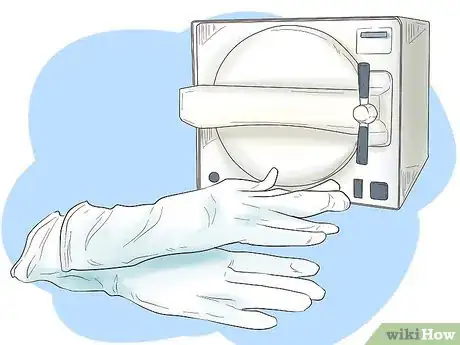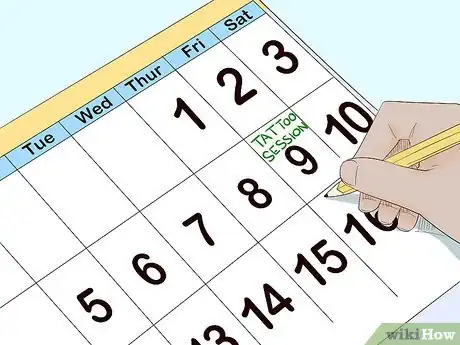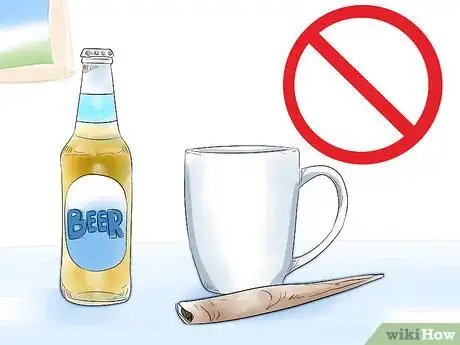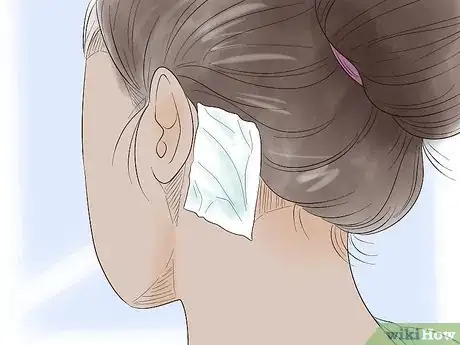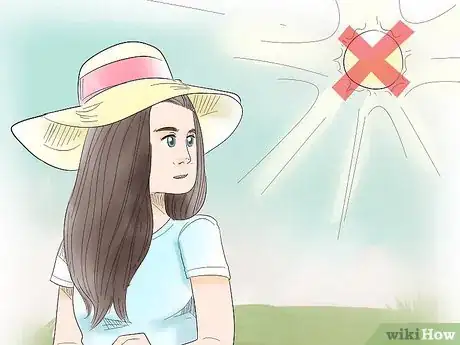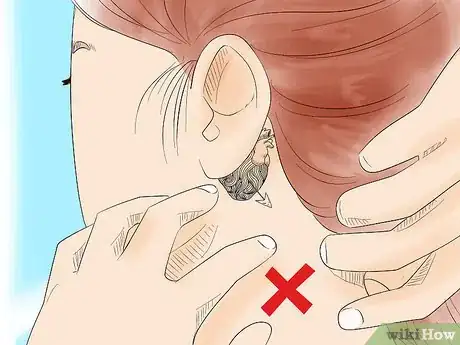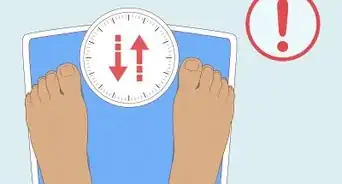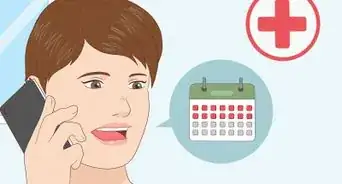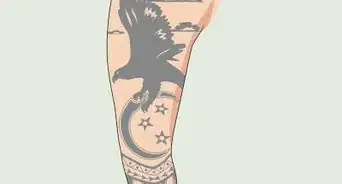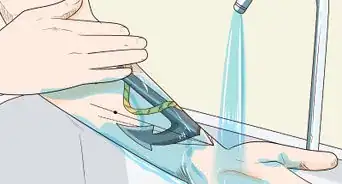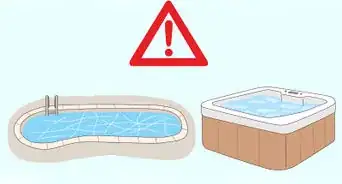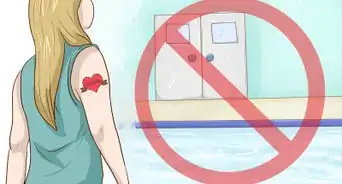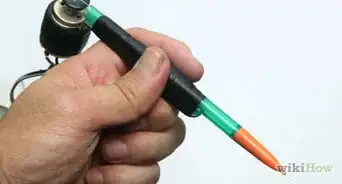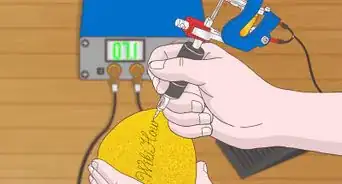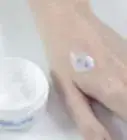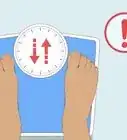This article was co-authored by Michelle Myles. Michelle Myles is the Co-owner of Daredevil Tattoo, a tattoo shop located based in New York City's Lower East Side. Michelle has more than 20 years of tattooing experience. She also operates the Daredevil Tattoo Museum, co-owner Brad Fink's personal collection of antique tattoo memorabilia that he has amassed over the last 27 years of tattooing.
There are 11 references cited in this article, which can be found at the bottom of the page.
This article has been viewed 39,629 times.
Are you looking to get a new tattoo in a discreet or unusual spot? One place many people choose is behind the ear. You can choose pretty, simple designs or larger and more elaborate motifs. Getting a tattoo behind your ear can be painful because the area is so sensitive. In rare cases, the sound of the vibrating needle can damage your hearing. You can get a behind the ear tattoo by finding the right artist for you, getting inked under the proper conditions, and taking care of your new artwork.
Steps
Finding a Tattoo Artist
-
1Locate different tattoo artists. The most important step in getting your tattoo is finding the right artist. Doing your homework can lead you to an artist whom you trust as well as offers the aesthetic you want for your tattoo.[1] [2]
- Ask family, friends, and acquaintances for recommendations of tattoo artists in your local area or beyond.
- Check tattoo magazines and social media accounts of different tattoo artists to see examples of their work. Most artists regularly update their accounts. You can also look up reviews of artists online.[3]
-
2Meet with potential artists. It’s important to feel comfortable and safe with your tattoo artist.[4] You also want to ensure that they practice in a hygienic environment with single-use needles.[5] Scheduling a consultation with potential artists can help you locate the best choice for the tattoo you want behind your ear.[6]
- Discuss your wishes for the tattoo, including color options such as grayscale. Ask about things such as cost, suggestions to optimize the artwork, and pain factor.[7]
Advertisement -
3Review hygiene practices. Tattoo artists should have autoclave sterilization as well as single-use, sterilized, and pre-packaged needles. Artists should also use gloves any time they are tattooing or touching another person.[8]
- Let the artist know of any skin conditions or other medical issues you have, both of which can increase your risk of infection. This may also affect how the artist tattoos you or if they feel comfortable proceeding.
-
4Schedule an appointment. After you meet several different artists, make an appointment in the near future with the one you like best. This allows the artist to draw the tattoo and consider the placement behind your ear. It can also help ensure that you don’t change your mind about the tattoo design or placement.
- Clarify costs and the time it will take to get inked with your artist. You may require one or two sessions to finish the tattoo. This often depends on how elaborate your design is.
- Ask if there are any pre-ink instructions you should follow. This may include not shaving or drinking a glass of orange juice.[9]
Getting Your Ink Done
-
1Rest the evening before your tattoo. You may be excited to get your tattoo, but it’s important to get a good night’s sleep. This will help you sit calmly while the artist inks behind your ear.[10]
-
2Observe good hygiene. Take a shower and wear clean, comfortable clothes to your appointment.[11] Getting a tattoo is an intimate experience and being clean for your appointment can help prevent potential infection and not offend your artist.[12]
- Wash your hair and use a gentle cloth to clean behind your ear. Pull up longer hair. The artist will clean the area again before your appointment.
-
3Eat before your appointment.[13] Have a full meal of protein-rich foods and some simple sugars before your tattooing session. This can give you energy and keep your blood sugar from plummeting during the appointment. It can also help you to sit more calmly.
- Choose heavier foods such as bison burger, guacamole, or an omelet for your meal. A glass of fruit juice or even soda will provide some simple sugar. Take a non-alcoholic drink and snack to eat during your appointment.[14]
-
4Avoid caffeine, alcohol, and drugs. Tattoo artists will not tattoo any person who arrives at their appointment under the influence of alcohol or drugs. This is illegal because you are neither in the mindset to make a serious decision, nor are you able to legally sign the liability waiver and consent forms that all artists require.[15] Recognize that alcohol, caffeine, and drugs can thin your blood, increase bleeding, and make it hard to tattoo behind your ear. They may also make it difficult for you to sit still during the appointment.
- Provide the artist a doctor’s permission note if you are using medical marijuana or another controlled substance for medical reasons. They may not ink you without one for liability reasons.
-
5Use pain medication with caution. Getting a tattoo can cause pain, though every person reacts differently to it. The area behind your ear may be more sensitive than other places. Talk to your tattoo artist about taking an over-the-counter pain medication or using a numbing cream before your appointment.
- Recognize that pain relievers or numbing creams may not dull pain for everyone. They can also thin your blood, which may make it harder to tattoo you.
- Follow the directions for taking a small amount of pain medication such as ibuprofen, acetaminophen, or naproxen sodium if you feel the need to take something.
-
6Relax as much as possible. You may have some fear or anxiety about pain when getting your tattoo. Listening to music or talking to the tattoo artist can help you relax. This may also help you get through the appointment more quickly.[16]
- Try breathing exercises to help you relax. You can also do positive reframing to distract yourself from the buzzing needle sounds.
- Talk to your tattoo artist if you like. Some artists may be more talkative than others.
-
7Take a break if necessary. Because the area behind your ear is so sensitive, you may have slightly more discomfort than usual. If any pain becomes unbearable, ask your artist if taking a short break is possible. This can allow you and them to regroup.
- Eat your snack and drink your beverage during your break. These can give you a boost of sugar that makes the rest of the appointment easier to bear.
-
8Give your artist a tip. Tattooing is a service industry and you should give your artist a little extra for doing the work. You’ll want to give them between 10-20%, depending on your satisfaction with the tattoo and experience.[17]
Caring for Your Tattoo
-
1Follow your artist’s after-care instructions. It will take 2-4 weeks for your tattoo to completely heal. After-care is important to ensure the tattoo heals properly and your color doesn’t fade. Discuss the after-care your artist suggests and ask any questions you have about how best to aid healing.[18] Call your artist at any time with questions you may have about after-care, including the best products to use. Tattoo after-care generally includes:[19]
- Keeping it wrapped and covered to prevent infection or contact with other things
- Washing twice a day with lukewarm water and scent- and alcohol-free soap
- Patting the area dry
-
2Stay out of the sun. Sunlight can fade tattoos, especially newly inked ones. Avoid sun exposure to the area behind your ear as much as possible. This includes from tanning beds. Putting a layer of broad spectrum UVA and UVB sunscreen can protect your new ink.[20]
- Cover your tattoo when you are outside. You can use a wide-brimmed hat, your hair, or a sunscreen designed specifically for protecting tattoos.
-
3Keep your fingers away from the tattoo. As your tattoo heals, your skin will form flaky scabs. These will fall off on their own. Avoid scratching, picking at or peeling off the tattooed area. This can affect the healing process and cause your ink to fade.[21]
- Use a water-based lotion or cream to moisturize the area. Steer clear of petroleum-based products, which can also cause the ink to fade.
-
4Take care of your body. The better you care for yourself, the better your tattoo will heal. Drinking lots of water, eating healthy meals, and getting enough rest can help your body heal quickly and trouble-free.
- Limit how much alcohol you consume. Drinking too much can also hinder the healing process.
-
5Watch for signs of infection. Tattoos rarely get infected, but it’s still important to watch for a potential problem. Seek medical attention if you notice any of the following on your tattoo:[22]
- Bleeding weeks after getting inked
- Green pus
- Constant redness
Expert Q&A
Did you know you can get expert answers for this article?
Unlock expert answers by supporting wikiHow
-
QuestionHow can I prepare for the pain of getting a tattoo?
 Michelle MylesMichelle Myles is the Co-owner of Daredevil Tattoo, a tattoo shop located based in New York City's Lower East Side. Michelle has more than 20 years of tattooing experience. She also operates the Daredevil Tattoo Museum, co-owner Brad Fink's personal collection of antique tattoo memorabilia that he has amassed over the last 27 years of tattooing.
Michelle MylesMichelle Myles is the Co-owner of Daredevil Tattoo, a tattoo shop located based in New York City's Lower East Side. Michelle has more than 20 years of tattooing experience. She also operates the Daredevil Tattoo Museum, co-owner Brad Fink's personal collection of antique tattoo memorabilia that he has amassed over the last 27 years of tattooing.
Tattoo Artist & Co-owner, Daredevil Tattoo The most important thing before you go in and get a tattoo is to get a good night's rest and to have something to eat before you go in. You want to be in as good shape as you can be when you get tattooed. And the secret to dealing with the pain is to relax as much as you can. The tenser you are, the more it hurts. If you can just really relax and concentrate on your breathing and keeping everything calm, then that actually makes it hurt less.
The most important thing before you go in and get a tattoo is to get a good night's rest and to have something to eat before you go in. You want to be in as good shape as you can be when you get tattooed. And the secret to dealing with the pain is to relax as much as you can. The tenser you are, the more it hurts. If you can just really relax and concentrate on your breathing and keeping everything calm, then that actually makes it hurt less. -
QuestionHow do I choose a good tattoo shop?
 Michelle MylesMichelle Myles is the Co-owner of Daredevil Tattoo, a tattoo shop located based in New York City's Lower East Side. Michelle has more than 20 years of tattooing experience. She also operates the Daredevil Tattoo Museum, co-owner Brad Fink's personal collection of antique tattoo memorabilia that he has amassed over the last 27 years of tattooing.
Michelle MylesMichelle Myles is the Co-owner of Daredevil Tattoo, a tattoo shop located based in New York City's Lower East Side. Michelle has more than 20 years of tattooing experience. She also operates the Daredevil Tattoo Museum, co-owner Brad Fink's personal collection of antique tattoo memorabilia that he has amassed over the last 27 years of tattooing.
Tattoo Artist & Co-owner, Daredevil Tattoo The most important thing is to really do your research and look at the artist's work. Either get a referral or just really look online at what makes a tattoo look like a good tattoo. Does it have nice, solid lines? Good solid color or smooth shading? Also, make sure that the tattoo shop is clean and reputable.
The most important thing is to really do your research and look at the artist's work. Either get a referral or just really look online at what makes a tattoo look like a good tattoo. Does it have nice, solid lines? Good solid color or smooth shading? Also, make sure that the tattoo shop is clean and reputable. -
QuestionHow do I prevent irritation after getting a tattoo?
 Michelle MylesMichelle Myles is the Co-owner of Daredevil Tattoo, a tattoo shop located based in New York City's Lower East Side. Michelle has more than 20 years of tattooing experience. She also operates the Daredevil Tattoo Museum, co-owner Brad Fink's personal collection of antique tattoo memorabilia that he has amassed over the last 27 years of tattooing.
Michelle MylesMichelle Myles is the Co-owner of Daredevil Tattoo, a tattoo shop located based in New York City's Lower East Side. Michelle has more than 20 years of tattooing experience. She also operates the Daredevil Tattoo Museum, co-owner Brad Fink's personal collection of antique tattoo memorabilia that he has amassed over the last 27 years of tattooing.
Tattoo Artist & Co-owner, Daredevil Tattoo
Warnings
- Consult state regulations if you want to get a tattoo and are under the age of 18. Some places prohibit it altogether, while others may require consent and presence of a parent or guardian during the procedure.[23]⧼thumbs_response⧽
References
- ↑ http://www.nylon.com/articles/everything-you-need-to-know-before-getting-tattooed
- ↑ Michelle Myles. Tattoo Artist. Expert Interview. 4 November 2019.
- ↑ http://www.mensfitness.com/styleandgrooming/5-things-know-getting-tatted
- ↑ http://www.inkedmag.com/10-tips-getting-tattoo/2/?ipp=3
- ↑ http://www.menshealth.com/health/what-to-know-before-getting-tattoo
- ↑ http://www.menshealth.com/health/what-to-know-before-getting-tattoo
- ↑ http://www.nylon.com/articles/everything-you-need-to-know-before-getting-tattooed
- ↑ http://www.menshealth.com/health/what-to-know-before-getting-tattoo
- ↑ http://www.menshealth.com/health/what-to-know-before-getting-tattoo
- ↑ Michelle Myles. Tattoo Artist. Expert Interview. 4 November 2019.
- ↑ http://www.inkedmag.com/10-tips-getting-tattoo/2/?ipp=3
- ↑ http://www.healthcentral.com/skin-care/c/149044/101175/twelve-prepare/
- ↑ Michelle Myles. Tattoo Artist. Expert Interview. 4 November 2019.
- ↑ http://www.inkedmag.com/10-tips-getting-tattoo/2/?ipp=3
- ↑ http://wholeaddictiontattoo.com/drugs-alcohol-and-tattoos/
- ↑ http://www.healthcentral.com/skin-care/c/149044/101175/twelve-prepare/
- ↑ http://www.businessinsider.com/this-is-how-much-you-should-tip-for-every-service-2012-8
- ↑ http://www.menshealth.com/health/what-to-know-before-getting-tattoo
- ↑ http://www.inkedmag.com/caring-new-tattoo-need-know/2/?ipp=3
- ↑ http://tattoohealingpro.com/your-new-tattoo-what-you-need-to-know-about-sun-exposure/
- ↑ http://www.menshealth.com/health/what-to-know-before-getting-tattoo
- ↑ http://www.nylon.com/articles/everything-you-need-to-know-before-getting-tattooed
- ↑ http://www.ncsl.org/research/health/tattooing-and-body-piercing.aspx


